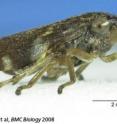Like an arrow: Jumping insects use archery techniques
Froghoppers, also known as spittlebugs, are the champion insect jumpers, capable of reaching heights of 700 mm - more than 100 times their own body length. Research published today in the open access journal BMC Biology reveals that they achieve their prowess by flexing bow-like structures between their hind legs and wings and releasing the energy in one giant leap in a catapult-like action. Froghoppers are well distributed around the world. Images of the insects flexing and jumping are described in the research carried out by Malcolm Burrows from the University of Cambridge and his colleagues. Burrows' research focused on determining how the energy generated by the insects' muscles is stored before powering a jump. He said, "A froghopper stores energy by bending a paired bow-shaped part of its internal skeleton called a 'pleural arch' which is a composite structure made of layers of hard cuticle and a rubbery protein called resilin. When the froghopper contracts its muscles to jump, these arches flex like a composite archery bow, and then on recoil catapult it forwards with a force that can be over 400 times its body mass".
There are further parallels with the jumping mechanisms of froghoppers and the design of composite bows used in archery. The composite of a hard and an elastic material means that the skeleton of a froghopper, or an archery bow, can resist damage even if they are bent for a long time. Froghoppers are observed to hold the pleural arch in a bent 'ready position', ready to jump at a moment's notice, and to be able to jump repeatedly without damaging the body.
Still more advantages of using composite structures when storing large amounts of energy are seen when considering the development of these storage structures. Froghopper nymphs live in a protective white foam, the familiar cuckoo spit that appears on plants in spring. These nymphs have no resilin in their pleural arches and don't jump until they complete the lifecycle and develop into adult Froghoppers.
Source: BioMed Central
Other sources
- Like an arrow: Jumping insects use archery techniquesfrom Biology News NetThu, 2 Oct 2008, 14:14:26 UTC
- Froghopper bug's incredible leaps explainedfrom MSNBC: ScienceTue, 30 Sep 2008, 20:42:07 UTC
- Like An Arrow: Jumping Insects Use Archery Techniquesfrom Science DailyTue, 30 Sep 2008, 19:35:18 UTC
- Like an arrow: Jumping insects use archery techniquesfrom Biology News NetTue, 30 Sep 2008, 15:14:21 UTC
- Like an arrow: Jumping insects use archery techniquesfrom PhysorgTue, 30 Sep 2008, 15:07:39 UTC
- Video: Jumping Insectsfrom Live ScienceMon, 29 Sep 2008, 23:35:09 UTC
- Froghopper jumping mechanism discoveredfrom UPIMon, 29 Sep 2008, 23:21:09 UTC
